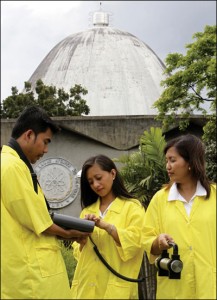Please don’t do foolish things …
MANILA, Philippines—Don’t panic and please don’t do foolish things.
Officials Monday issued the advice as they dismissed as hoax text messages warning that radioactive fallout from crippled nuclear plants in Japan would reach the Philippines.
They urged the public to refrain from spreading unconfirmed reports and pseudo-scientific advisories through text messages, saying this causes undue panic.
Dr. Eric Tayag, head of the Department of Health’s National Epidemiology Center, said he received reports that some people wanted to smear iodine solutions on their necks to protect themselves from radioactive particles blowing in from Japan.
“Actually, potassium iodide or salt is taken to prevent cancers involving the thyroid. It displaces the radioactive iodine if that is the radioactive particle,” Tayag said at a press conference.
But potassium iodide could be useless if a different radioactive element was involved, like plutonium, Tayag said. “If plutonium is the radioactive particle, that would entail a different treatment so please don’t do foolish things,” he said.
Worst-case scenario
Assuming that a worst-case scenario would happen in the country, Tayag said it was advisable to “just remove your clothes and shoes and take a shower to decontaminate yourselves.”
If radioactive particles reached the country, its components would have “decayed depending on its half-life” because of the long distance it traveled, Tayag said. Manila is about 3,000 kilometers south of Tokyo.
Although exposure to radiation is a health concern with acute and long-term effects, such a condition is influenced by several factors: the type of radioactive particles involved, the amount and the duration of exposure and the distance from the source of the radioactive leak, Tayag explained.
Early symptoms of radiation exposure include vomiting, nausea, diarrhea and fever. Symptoms for more serious conditions include headache and hair loss, among others. Chronic effects of extreme radiation exposure include cancers and genetic malformations.
“I understand where this fear is coming from … because if you look at the map, the Philippines is just an inch away from Japan but there is really no need to panic or to worry,” Tayag said.
Dr. Soe Nyunt-U, country director of the World Health Organization, said there was no need for “undue alarm” as prevailing wind conditions showed that the Philippines was out of the path of the plume emanating from the site of the nuclear explosion.
“Even if this happens, radioactive materials won’t come to the Philippines. There are minimal public safety issues even in Japan and what is happening right now doesn’t have any implications to the rest of the members of the Western Pacific region,” Soe said.
Alumanda de la Rosa, Philippine Nuclear Research Institute (PNRI) chief, said “there is no nuclear cloud from Japan” even after the second explosion at a nuclear plant Monday morning.
Country not in danger
De la Rosa also noted that information from the nuclear plant showed that the Philippines was not in danger.
“From what we’ve been monitoring, no radiation will reach here. There will be no exposure to the public,” she said.
De la Rosa said the International Atomic Energy Agency placed the Fukishima explosion, which injured several workers, at Level 4, on a 7-level scale.
The 1986 meltdown in Chernobyl was placed at Level 7, which indicates a major release of radioactive materials and widespread and extended health and environmental effects.
A Level 4 incident means that there “is an accident but there is no significant effect offsite,” the PNRI official said.
Normal levels
In a statement on Monday, t
Should there be a complete nuclear meltdown and a nuclear cloud forms, a remote possibility for now, scientists said the plume from the site of the incident would not pass Philippine territory as of March 14, PNRI said, citing an advisory from the World Meteorological Organization.
The Philippine Atmospheric, Geophysical, and Astronomical Services Administration (PAGASA) said the winds from Japan would not travel to the country.
PAGASA chief forecaster Robert Sawi said the winds were moving west to east, or from Japan to the Pacific Ocean.
Sawi and De la Rosa appealed to the public not to spread text messages about apocalyptic scenarios. “It does not help us at all,” De la Rosa said.
She noted that the public should wait for the advisories from the Department of Science and Technology or call the concerned agencies to confirm reports.
Malacañang also chided people for spreading rumors. “Science Secretary (Mario) Montejo says there’s no immediate threat to the country from the nuclear accident,” Communications Secretary Ricky Carandang said.
President Benigno Aquino III met with Montejo and other officials for a briefing on the situation in Japan.
In Central Visayas, government agencies called a press conference to counter the text messages. With reports from Dona Pazzibugan in Manila and Candeze R. Mongaya, Cebu Daily News